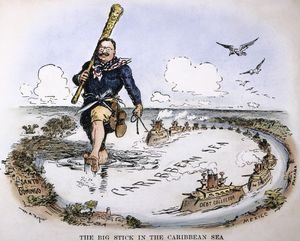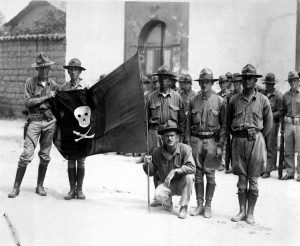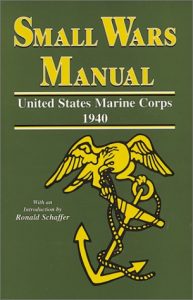“Theodore Roosevelt and his Big Stick in the Caribbean”, Harper’s Weekly (1904)

This political cartoon was drawn by William Allen Rogers and published in Harper’s Weekly in 1904. The cartoon depicts a massive Theodore Roosevelt marching across the Caribbean Sea, surrounded by Latin American countries, and pulling trade ships with a string while hoisting a huge bat over his shoulder labeled the “Big Stick”. This refers to Roosevelt’s diplomatic doctrine of big stick diplomacy, in which the United States used its military might and political influence to coerce Latin American countries into advancing US goals. Although this diplomatic strategy did not include direct military intervention, it indicates growing American influence and political pressure in the region, and could perhaps be seen as a precursor to the military interventions that took place during the Banana Wars. It is also directly related to the Monroe Doctrine, which effectively established Latin America as a US sphere of influence.
“Small Wars Manual: United States Marine Corps”, United States Government (1940)
The Small Wars Manual was a United States military document published in 1940 that was meant to be used as a guideline for American military interventions in small conflicts. The manual was based on Major Samuel M. Harrington’s 1921 report The Strategy and Tactics of Small Wars (which would have been better suited to this section due to its date of publication, but is unfortunately no longer available), and covers everything from technical military concepts like logistics and training, to political tools such as the disarmament of populations and supervision of local elections. This manual and the 1921 report it was based on are both extremely significant, as they demonstrate the rise of American interventionism both militarily and politically. The need for such a document would not be necessary if the United States didn’t plan on intervening in foreign conflicts and affairs, so the manual also shows that this is the direction chosen by US foreign policy starting in the early 20th century.
“U.S. Marines with the captured flag of Augusto César Sandino of Nicaragua”, uncredited US Marine photographer (1932)

This photograph, which was captured by an unknown photographer in 1932, depicts a line up of US Marines posing next to a recovered flag of Augusto C. Sandino, a Nicaraguan revolutionary who led guerrilla fighting against the American occupation. This photo displays just one example of American interventionism in Latin America, and was part of the Banana Wars—a series of American military occupations and interventions in Central America with the goal of preserving US commercial interests in the region and maintaining its sphere of influence. It is important to note that Sandino is now a revered figure in Nicaraguan history, and was named a national hero by the Nicaraguan congress in 2010.

